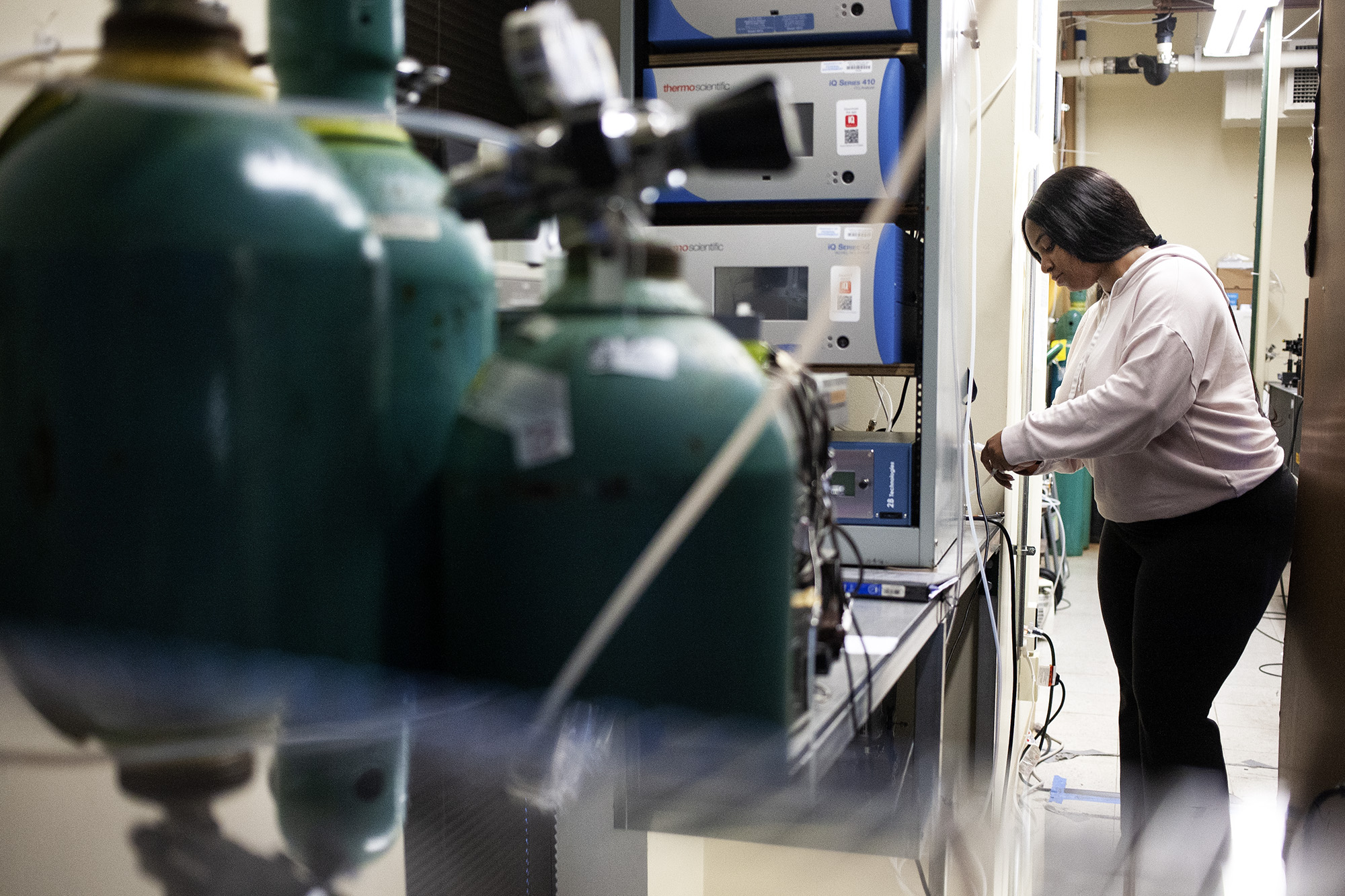Graduate Program
The Department of Physics offers a Masters of Science in Physics and a Masters of Science in Physics with a concentration in Atmospheric Sciences. The department also participates in the Applied Science and Technology Ph.D. program. Students can receive training in many areas of pure and applied physics. Please see the Academics and Research pages for details.
Why you should choose our program

- Our Master of Science program is aimed at preparing students well to transition to any Ph.D. program and is designed to bridge the gap between undergraduate and graduate school.
- The program prepares students for careers and jobs in private and government organizations by providing hands-on research experience in several applied areas: Biophysics, Materials Physics, Atmospheric Chemistry and Physics, Air Quality, Atmospheric Science Meteorology, Astrophysics, and Nuclear Physics.
- We offer a flexible MS program with three different options (Thesis option, Project option, and Course-only option) and fewer core courses so students can design their curriculum and customize their degree according to their career goals.
Our students are taught and mentored by
Faculty with national and international recognition
2
APS Fellows Prof. Lesher and Prof. Gasparian are Fellows of the American Physical Society
3
NSF Career Awards Three faculty members have received NSF Career awards
2%
Worldclass scientists Faculty included in world's top 2% of scientists
Notable graduates of MS Physics and Meteorology Program
Benjamin McCarter - MS in Physics 1998 (Atomic and Molecular Physics)
Application Engineer/Project Manager in Specialty Materials at Corning Incorporated
Britney Hamilton - MS, 2016 (Atmospheric Sciences and Meteorology)
Meteorologist, Spectrum TV
Israel Begashaw - MS 2008 (Atmospheric Physics)
Senior Scientist and Support Manager LiCore Environmental
Mariah Bush - MS 2020 (Atmospheric Sciences and Meteorology)
Meteorologist, KVVR FOX News, Fargo, North Dakota.
Patrick Pete - MS, 2013 (Atmospheric Sciences and Meteorology)
Meteorologist at WMAR-2 TV
Vivek Komaragiri - MS 2004 (Atomic Molecular Physics)
Chief Technology Officer at Sensory Analytics
A number of our MS graduates have also gone to PhD programs and successfully obtained PhD degrees and are working in academic, government, and private organizations.
Graduate faculty and their research
(Check the Research page for details.)
Ademe Makonnen’s research interest is in tropical climate variability change, convection and wave disturbances, and tropical cyclogenesis. His major objective is to better understand the multiscale interaction between wave disturbances and different types of deep convection that have important implications on precipitation and tropical cyclogenesis.
Funding Source: National Sciences Foundation (NSF).
Ashot Gaparian’s group research in Experimental Nuclear Physics is currently conducting research in two subfields of nuclear/particle physics: (a) the structure and properties of visible matter, and (b) search for new, yet unknown particles in our Universe. The group addressed a fundamental question “proton radius puzzle” and developed a new experimental method at Jefferson Laboratory, with the result published in Nature. The group worked with a large group of collaborators to develop a new experimental project to search for new, yet unknown, particles in nature. The work might lead to the existence of a fifth force.
Funding Source: National Sciences Foundation (NSF)
Athina Meli's research focuses on aspects of the high-energy astrophysics and astro-particle physics, astrophysical relativistic sources, and their jets. The mechanisms of the origin and acceleration of the high energy cosmic rays from astrophysical sources is the central focal study point using phenomenology or computational simulations. Her research includes relativistic Monte-Carlo and Particle-in-Cell simulations of astrophysical plasma jets, by investigating the micro-kinematic effects the magnetized jets have into the acceleration of cosmic-rays. She also studies the phenomenological role that the cosmic rays play to the multi- messenger astrophysical aspects which connect the cosmic-rays with the gamma-rays, gravitational waves and neutrino emission.
Charlotte Wood’s research interests focus on supernova cosmology and type 1a supernova progenitors, as well as light echoes, binary white dwarf systems, and brown dwarfs.
Chih Kuan Tung’s research uses sperm and microfluidic devices to study (1) how the physical features naturally present in the mammalian female reproductive tract influence sperm motility; (2) the statistical physics of constituents that actively consume energy and propel themselves. His group uses imaging and physics models to elucidate how sperm interact with the female tract physically. Further, they compare the statistics of an ensemble of sperm to existing active matter theory to improve our understanding.
Funding Source: National Sciences Foundation (NSF).
Jing Zhang's research focus is on regional climate and weather studies, such as dynamic downscaling for climate impact assessment; regional reanalysis and mesoscale modeling over complex terrain; Arctic circulation, cyclones, and poleward moisture transport; land/ice/snow surface processes and interaction with atmosphere including the development of a snow/ice enhanced WRF-ice model; and real-time weather forecast.
Funding Source: National Sciences Foundation (NSF).
Joanna Atkin's research is in the development and use of novel optical spectroscopy techniques to understand nanoscale and quantum materials. Her group uses experimental and computational tools to investigate structure and electronic properties of nanoparticles, thin films, and quantum confined systems.
Solomon Bililign’s group research involves the use of several experimental spectroscopic techniques, modeling, and field observations for atmospheric applications. The focus of the research is to measure the optical and chemical properties of biomass burning aerosols generated by burning African fuels using an indoor smog chamber to mimic real atmosphere. Theoretical methods use Transmission Electron Microscopy images to derive refractive indices of the particles. The overall goal is to understand the role of biomass burning aerosols on climate, air quality and human health.
Funding sources: National Science Foundation (NSF), Department of Energy (DoE) and
Department of State (DoS).
Yuh Lang Lin’s research is in Mesoscale Dynamics and Modeling with focus on Hurricanes and Typhoons, Wildfires, Orographic Effects on Airflow and Weather Systems, Convective Storms, Gravity Waves, and Turbulence, and Cloud Microphysics.
Funding Source: National Sciences Foundation (NSF)
Contact
For more information about our graduate program or schedule a visit to our department please contact the gradaute coordinator:
Dr. Solomon Bililign
bililign@ncat.edu
336-285-2328


